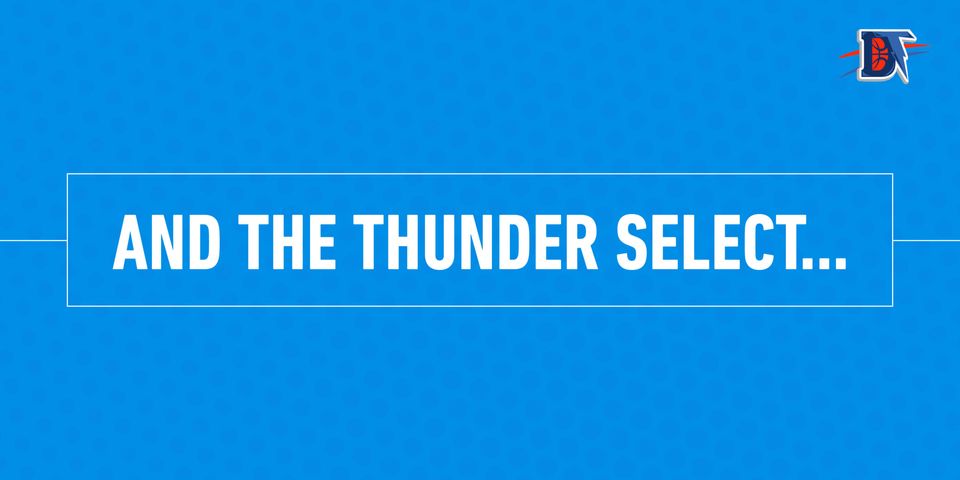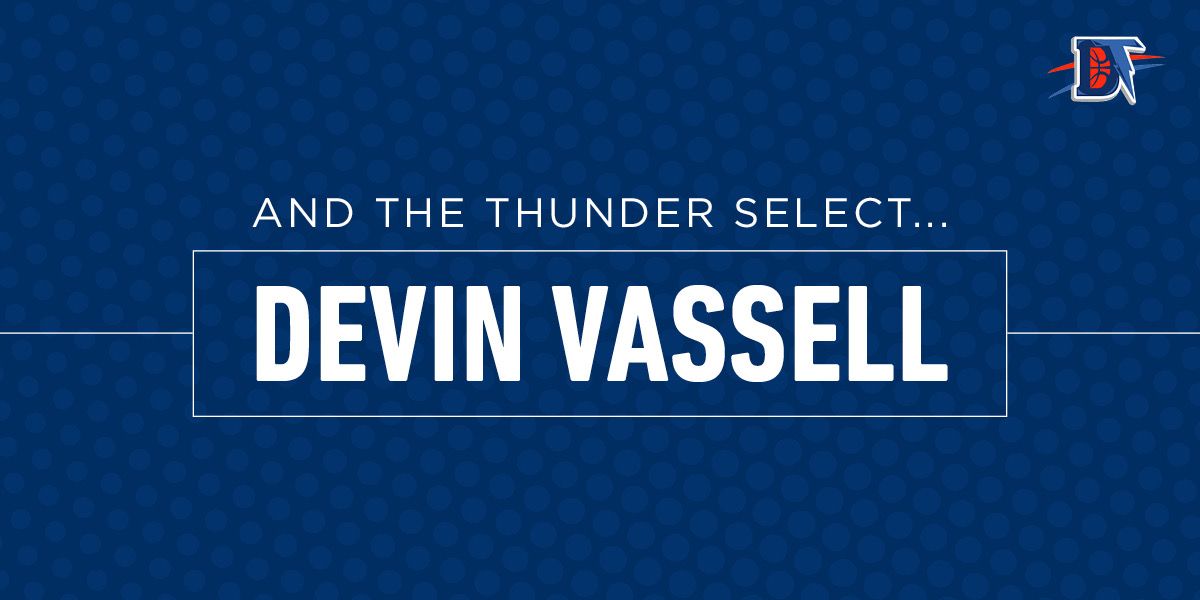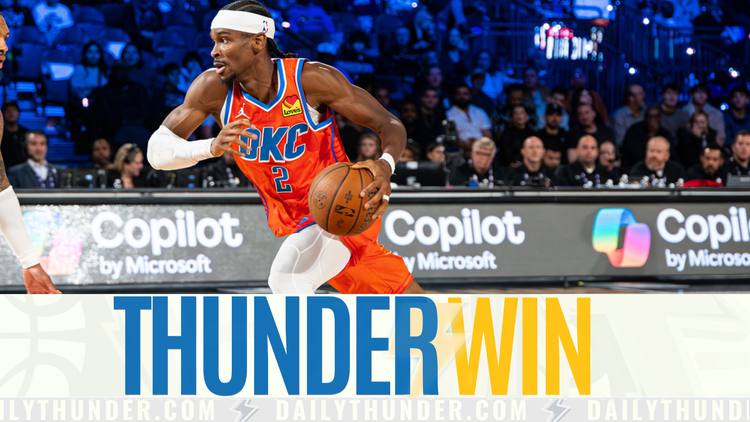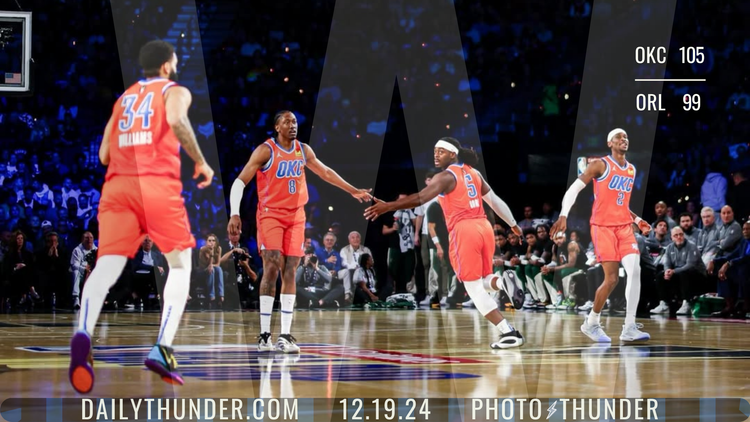And the Thunder Select: A Guide to the 2020 Draft

With a bounty of draft picks from the 2019 Tradepocalypse summer, the Thunder will be scouting young prospects at the top of recruiting and draft classes once again. Daily Thunder will keep you informed on whether those players look like good targets for Oklahoma City.

The Thunder’s upcoming selection(s) can help jumpstart their rebuild and catapult them to contention sooner than you might think. As of this writing, OKC is armed with the 25th, 28th & 53rd pick, which is likely the lowest range VP & GM Sam Presti and the rest of the front office will be drafting from for a long time. That makes this a pivotal selection of what will hopefully become a role player or even a potential starter down the line.
With that in mind, I’m going to be diving into some prospects that OKC could be interested in for each of their picks, delving into whether or not I think these players are worthy of selection and how they could fit on this year’s Thunder roster. I’m looking at my personal rankings for these players as well as where I think their range of outcomes will be on draft night. (For example, I’m not going to be listing Cassius Stanley anywhere near this pick because I don’t believe he’s worthy of being taken in the first round.)
Let’s jump in.
Targets at Pick 25/28
Aleksej Pokusevski – F/C, Greece
With what would be a dream scenario for the Thunder, the unicorn big man out of Serbia, Aleksej Pokusevski, falls to them at pick 25. Pokusevski is a 7’ big man with a 7’3 wingspan who looks like a guard when roaming the perimeter, with a very capable handle/playmaking skills and a nice perimeter shot to boot. If you were to ask me to name the best non point guard passer in this year’s class, my answer might be Pokusevski. He’s already flashed some high level ability in finding open shooters and dropping the ball off when going towards the rim, and he’s even shown some flair with behind the back passes. Last year he dominated the same Greek second League that 2x NBA MVP Giannis Antetokounmpo did, averaging 10.8 points, 7.9 rebounds, and 1.8 blocks per game for Olympiacos. Despite his great length, Pokusevski is still very skinny (around 195 pounds) and his physical development will play a huge role in whether or not he hits his ceiling. Due to this, I see him playing more power forward in the NBA as of right now, but if he gains weight and puts on muscle I can see him playing the five as well. Pokusevski will be a very intriguing draft-and-stash option for the Thunder (if they choose to go that route) and while I have my doubts about him falling this far, he would make a great frontcourt partner with Shai Gilgeous-Alexander in the future and would be the stretch big that the Thunder have been coveting for what seems like forever.
Xavier Tillman – C, Michigan State
I haven’t seen too much first round buzz among the national media for Xavier Tillman this offseason, and I have no idea why. Tillman is the perfect well-rounded role player that teams covet, in the mold of a Draymond Green who can help elevate teams in a playoff setting. Tillman is very strong, and at 6’8 and around 267 pounds, he should be able to hang with most of the centers in today’s NBA. He is a terrific screener and defender, with some of the best defensive ability in this entire draft. He is also a master in the short-roll, with the ability to quickly process the defense and either kick it out to shooters on the perimeter or take it himself. Tillman was a phenomenal interior defender in college; combining that with his passing and potential perimeter shot (still a work in progress) he should be an excellent addition for teams in the back half of the first round. With the Thunder, Tillman will be able to come in immediately and man the backup center spot depending on what they decide to do with Nerlens Noel, and he should be able to eventually step into the starting role if/when Steven Adams leaves. Even though center is not a flashy position, and Tillman doesn’t necessarily make a ton of splash plays like an above the rim center might, he should be a high impact player at the next level and will make it hard on the Thunder’s decision makers to pass up on.
Athleticism Score: Shoutout to NBAthlete for providing this data, as it’s based off the NBA combine results.
- bSPARQ: 91.80
- NBA%: 61.7
Josh Green – G, Arizona
Josh Green is your prototypical Thunder draft pick, an athlete who has shown good defensive ability but so far has displayed lackluster ability on the offensive end. Green is a 6’6 guard with a 6’10 wingspan–good size on the perimeter. His quick feet and good defensive instincts allow him to play passing lanes quite well, evident by his 2.8% steal rate this past season at Arizona. His offense is shaky, as he’s not much of an on-ball creator at all and struggles mightily shooting off the dribble. He’s a solid shooter off the catch but didn’t show much else at Arizona offensively, as he struggled with his finishing at times and couldn’t create in isolation at all. The 36 percent he shot from three at Arizona could be deceiving, as his volume was low (83 attempts all year) and he was treated as almost a non shooter, leaving a majority of his attempts open. At Arizona, Green was able to play well in an off-ball role as Nico Mannion handled a majority of the on ball work, and that could be the same situation in OKC. Green can come to the Thunder and play exactly the same role as Lu Dort did last season. As Terrance Ferguson fades out of the rotation, Green can soak up those minutes as a solid wing defender with positional versatility and as a catch-and-shoot specialist while continuing to expand his offensive game with the Thunder.
Athleticism Score:
- bSPARQ: 87.44
- NBA%: 69.0
Desmond Bane – G, TCU
Desmond Bane has been rising on boards ever since the college season was cancelled, all the way up to a top-30 prospect after being primarily mocked in the second round before covid struck hoops. On my board, I would have Bane in the 15-20 range, as he possesses all the skills and qualities that you would want in a premier role player. Bane is a top three shooter in this class (if not the best), with every skill that you would want, whether that’s relocation, spot-up, catch-and-shoot, and more. Over his past three seasons at TCU, Bane shot 44% from three on nearly 500 attempts. Not only is he a lethal shooter, but he’s also a very good passer for a shooting guard, with ability to run the P&R as an on-ball guard. Due to his stock at the moment, which is seemingly the late first/early second round, he likely won’t get as many on ball reps as you would want, but Bane will be able to step in right away as a knockdown shooter, potential secondary/tertiary playmaker, and a very solid defender for your team. Standing at 6’6 with a 6’4 wingspan, Bane doesn’t necessarily have the length to be a premier defender in the NBA, but his defensive awareness and IQ coupled with his strong upper body will allow him to defend guards at an above average level. For the Thunder, Bane will be what the Thunder have been looking for in a long time: a very good bench role player who can potentially help push the team over the top in the playoffs down the line.
Tyler Bey – F, Colorado
Even if re-signed, Andre Roberson might not be the only Colorado forward on the roster next year. Tyler Bey is in the same mold as Roberson coming out of school, an exceptional athlete with great defensive skills and instincts, coupled with a questionable offensive game. However, Bey projects to be much better than Roberson was on the offensive end. Bey ended up setting the NBA combine record for max vertical by a forward, coming in at 43.5 inches. This is evident on film, as it makes Bey that much more of an impactful defender. He had a 3.1 STL% and a 4.2 BLK% last season at Colorado, clearing the threshold of 2.5% for each. Bey’s 3.54 D-PIPM ranks 7th in this draft class in my database, and he’s the perfect switchable forward in today’s modern NBA. He was a master at defensive rotations at Colorado, and was also an excellent transition defender. On offense, Bey supports a stellar FTr of .538 for his career, but he’s not much of a perimeter shooter as of now. He has shown a bit of ability as a movement shooter, but his percentages have yet to catch up to that yet, as he shot 31% from three for his career on very low volume (59 attempts over three years). I would bet on Bey’s shooting becoming much better however, as his mechanics are solid; he managed to shoot 42% last season, albeit on very low volume.
Athleticism score:
- bSPARQ: 100.80
- NBA%: 92.9%
Malachi Flynn – G, San Diego State
Malachi Flynn is someone who I had overlooked due to his lack of athleticism early on, but now I have him firmly in the first round of this upcoming draft. Flynn was a transfer from Washington State and was able to up his draft stock at SDSU. Standing at only 6’1, 185 lbs. and only a 6’3 wingspan, size is one of the only detriments in Flynn’s game. He was a premier P&R ball handler in college–ranking in the 96th percentile this past season–and is an excellent shooter out of these actions. Despite his size, Flynn is a good and active defender. He fights hard on that end, and wins a lot of gambles for steals as evidenced by his 3.2 STL%. Flynn is about as NBA ready as they come for a back half of the first round player, with a very translatable skillset that will propel him to become one of the best backup guards in the league, or hopefully a potential starter down the line.
Grant Riller – G, Charleston
In this draft class, Grant Riller is one of the best bets to immediately come in and be a scorer in the NBA. At Charleston, Riller had three straight seasons of 18+ points per game and 60+ TS%, accomplishing this almost all by himself. At only 6’1, Riller has been one of the best finishers to come out in the draft in years. Last season Riller shot 70.6 percent at the rim despite only being assisted on 13.9 percent of his makes. He combines a great first step and an above average handle to get to them rim, and he is able to finish with a wide variety of layups that he’s showcased over the years. Riller is a true three level scorer, excelling in isolation, handling the ball in the P&R, and in spot-up shooting opportunities. He shot 36% last season on a little over four attempts per game. However, his huge on ball role at Charleston makes the percentage appear slightly worse than it might be in the NBA, where he could have more off ball reps and excel as a spot-up shooter next to another initiator. On the Thunder, it’s hard to think of a better replacement in the draft for Dennis Schroder than someone like Riller, who has a scoring mentality and can be an instant offensive spark plug off the bench.
Athleticism score:
- bSPARQ: 79.71
- NBA%: 49.6%
Isaiah Joe – G, Arkansas
If the Thunder are looking for a shooter in this upcoming draft, there might not be a better option than Isaiah Joe. Joe was a sniper at Arkansas, launching over 10 threes a game per 40 minutes in both his seasons in school. His accuracy dipped from 41.4 percent his freshman year to 34.2 percent this past year, but the highs of his makes are still there. He takes and makes incredibly difficult shots and has no issue with pulling up from NBA range and beyond multiple times a game. Joe has a very quick release which lets him get up shots in a hurry and is willing to take a shot from every angle possible. Joe is more than just a shooter, though; he’s shown apt playmaking skills and fights hard on defense despite his lack of strength. The Thunder have been looking for a high level off the bounce shooter for a while now, and Joe can come off the bench and be an instant flamethrower behind the arc for OKC.
Avoid at 25/28
Cassius Stanley – G, Duke
At 21 years of age, Cassius Stanley is incredibly old for a one and done college player. Keep this in mind when you are evaluating Stanley and looking at his statistics, as he should realistically be a junior in college right now. Stanley is an incredibly gifted vertical athlete, registering a 44 inch max vert at the NBA combine. However, that’s about where the praise ends. Stanley shot decent from three this past season at Duke (36% on 86 attempts), but you have to remember that he was treated as a non-shooter by most teams, leaving him wide open in the process. According to Bart Torvik, 100% of Stanley’s three point makes were assisted this past year, making him a very stationary and non versatile shooter who struggles with self creation. He lacks discipline on defense, often losing his man and getting beat on backdoors, and he has almost zero self creation ability or ability to create for others. At his best, you’re getting an adequate three point shooter and a crazy vertical athlete–not worth a first round pick in my opinion. I’d even debate on drafting him with the 53rd pick, as I’d rather take a gamble on a player with a better primary skill than Stanley possesses.
Athleticism score:
- bSPARQ: 91.58
- NBA%: 85.2
Isaiah Stewart – C, Washington
Isaiah Stewart is someone that I am, along with most other draft nerds, lower on than the consensus. When drafting a big man, if the player doesn’t have outlier traits like Pokusevski’s shooting and movement, or Tillman’s defensive ability and high IQ, then I don’t want any part of said player in the first round. Stewart is built incredibly well, coming in at 6’9 250 with a 7’4 wingspan, and you would think that this would make him a great athlete. But it doesn’t. Stewart has very little vertical explosion (long load time), which hurts when finishing at the rim offensively and contesting at the rim defensively. His mechanics and FT percentage leave some optimism for a potential perimeter shot becoming a part of his arsenal in due time, however there are more players I would rather bet on with more translatable and valuable skillsets than what Stewart possesses.
Jaden McDaniels – F, Washington
Next up is Isaiah Stewart’s teammate, Jaden McDaniels, a prospect I am much lower on than the mainstream consensus. Up to this point in his career, the idea of McDaniels has always vastly been better than his actual on court impact. Touted as another “KD like” prospect, McDaniels has great size (6’9 with a 6’11 wingspan), and is quite mobile and a fluid athlete for his size. Despite his length and being a “toolsy” athlete, McDaniels lacks an explosive first step and doesn’t have great vertical pop, which limits him in self creation opportunities and finishing above the rim. Jaden’s shot selection over his season at Washington was very bad, and despite him flashing a potential solid outside shot for his size, he had just a 51.5 TS% this past season. It certainly doesn’t help that despite being a poor vertical athlete, Jaden is also incredibly weak and loses his physical matchup almost every time. Jaden is the classic “upside” pick in this class, and he’s the athletic forward whose draft profiles are full of empty platitudes talking about his movement ability, shooting for his size, etc., despite him not showing that he’s any good at basketball in college.
Targets at Pick 53
Killian Tillie – C/F, Gonzaga
In a perfect world, Killian Tillie would be gone long before this pick because he would have the ability to consistently stay healthy. Tillie is a very talented big man who thrives on the perimeter with elite shooting, very good passing for his size, and a high level feel for the game. Not only is his offense good, but he has been very good in college defensively, with his fluidity and IQ making him of the best team defenders among big men in this class. He’s been one of the best and most impactful players in college since he played his first game for the Zags. In his two healthy college seasons, Tillie has put up 11.8 points, 5.2 rebounds, and 1.7 assists on 55% from the field and 44% from three in 25 minutes a game. If Tillie manages to stay healthy, he has a very likely path to becoming the steal of the draft for a team like the Thunder. He’ll provide OKC with a versatile big man who can be a seamless plug and play backup for the time being, and hopefully develop into a starting center or forward in the future.
Sam Merrill – G, Utah State
Despite being 24 years old, Sam Merrill is a good basketball player, thus making him a potential target for the Thunder in the second round. Merrill is an excellent shooter, converting 42% shots from three on 759 attempts during his four years at Utah State. He’s a very versatile shooter, who is a pro at running off of screens and off of movement in general. Although a poor athlete, Merrill has some creation ability due to his impressive passing he displayed throughout college. He will be able to run a few P&R’s at the next level. On defense, Merrill doesn’t project to have much impact. He’s smart and disciplined on that end, but his lack of athleticism might really hinder him against NBA competition. For teams looking at a knockdown shooter and potential offensive weapon due to the emergence of players such as Duncan Robinson, Merrill is your guy in the second round. The Thunder could snag him at 53 and have an elite shooter on their roster for the foreseeable future, but his ceiling will depend on how he holds up on the defensive end.
Jalen Harris – G, Nevada
Jalen Harris was a scoring machine at Nevada. The 6’5 guard averaged 22 points on 56% TS last season after sitting out a year due to transfer. A very good iso scorer at the collegiate level, Harris landed in the 90th percentile in isolation scoring this past season. Harris is also a good athlete, recording a 37.5 inch standing vert at this years combine (the highest mark over the past four seasons). Besides being a deadly scorer, Harris operates very well in the P&R, ranking in the 88th percentile as a P&R ball handler. Harris is a perfect candidate to be this year’s draft steal in the second round due to the high scoring games he will be able to put up in the NBA. He will no doubt make a team very happy if he manages to slip this far. With the recent departures of Schroder and Chris Paul, Harris can step right into a backup role with the Thunder, bringing a dynamic offensive ability off the bench.
Marko Simonovic – C, Mega Bemax
Marko Simonovic is a draft-and-stash 6’11 big man with outside shooting skill. A good decision maker on the short roll, Simonovic is a smart player with a high IQ on both ends, but he struggles defensively at times due to his lack of physicality and high end athleticism. The Thunder haven’t had much success with draft-and-stash players, however I think Simonovic can bring potential value to the team down the line with his intriguing skillset for his size.
Paul Reed – F, DePaul
Offense for Paul Reed is still a major work in progress, who is a solid free throw shooter who hasn’t shown a consistent ability to hit shots from behind the arc, which can significantly hamper his potential in the NBA. A terrific defender in college with very good length (6’9 with a 7’2 wingspan), Reed averaged 5.6 stocks (steals + blocks) per 40 minutes and had a STL% of 3.3 and a BLK% of 9.7. Reed is a good finisher for his size, whose athletic ability really shines down low with lobs and passes inside as well as in transition. Reed will be very context dependent early on his career, as he figures out his shot and what his offensive role in the NBA will be.
Skylar Mays – G, LSU
At 23 years old, Skylar Mays may be a little old for some fans’ liking, however that doesn’t change the fact that he’s unequivocally a good basketball player and will have a lengthy NBA career despite his draft position. Mays is a good shooter who saw a big increase in his percentages last season (3PT% up to 39.4 percent) and combined with his career FT percentage of 84.5, I believe that his shot has always been better than his output in his first three years in school. It’s closer to what he displayed that senior season. Mays was a 98th percentile P&R ball handler last season at LSU and should be a key offensive cog off a team’s bench, whether that be in an on- or off-ball role. Lacking high end length and athleticism, Mays has had his issues finishing at the rim, especially in 2019 when he shot 56.9 percent on 167 attempts. Defensively, Mays will have a disadvantage physically most of the time, but his high IQ and career 3.0 STL% in college could have him playing better than most might expect on that end of the floor. On the Thunder, Mays will have a potential bench role waiting for him, filling in as a high feel guy who can hopefully translate to a consistent role player for the team.
Nate Hinton – G, Houston
If you’re looking for a high motor in this years class, Nate Hinton might be at the top of that list. Standing at only 6’5, Hinton is one of the best guard rebounders I’ve seen in recent years, averaging an absurd 11.5 boards per 40 minutes this past season. In addition to his fantastic rebounding, Hinton is a good individual & team defender, possessing quick hands and a high IQ on that end that helps rack up steals and shut off of passing lanes. Offensively, Hinton is a good shooter (38.7 percent from deep this season) and is a very capable catch and shooter player. Hinton falling this far would be a major steal; I’ve yet to see any mocks with him much higher than this, giving the Thunder to select a high energy rotation piece with one of the last picks in the draft.




